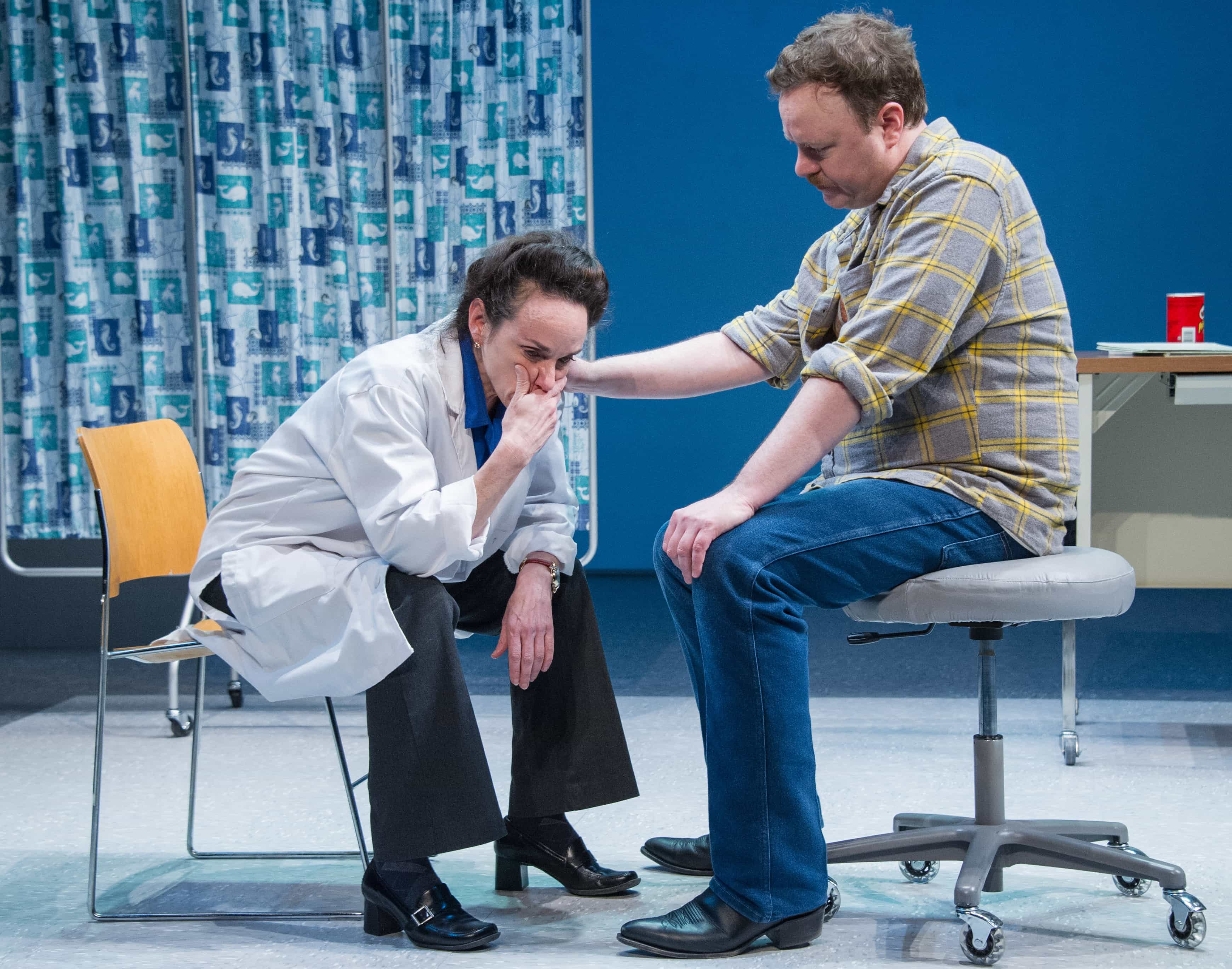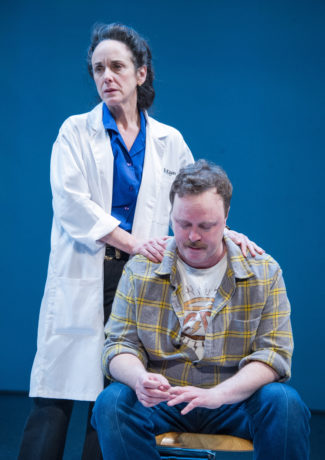Fierce. No word short of that can fairly describe the characters’ commitment to their consuming passions, and the actors’ commitment to their roles, in Theater J’s harrowing production of Karen Hartman’s Roz and Ray.
Ray Leon (Tom Story), a blue-collar Texan now living in San Diego, is the single father of two hemophiliac sons, their protector and advocate. Nothing means more to him than giving them a chance for survival – he dreams of them becoming 70 – and a normal life, with football and girls and children.

Dr. Roz Kagan (Susan Rome), a hematologist at a children’s hospital (as was Hartman’s father during this period), is dedicated to being a different kind of doctor, passionately desiring to be a human presence to her patients as well as an early adapter of medical advances. She cares with every fiber of her being. She deeply admires Ray’s commitment to his children.
Elated when Roz suggests an innovative, less difficult, more efficient treatment for his children, Ray initially views her as a kind of miracle worker. And yet, by the play’s second scene, flashing forward to 1991, Ray is picketing her hospital’s fund-raiser, yelling over and over that “Dr. Roz Kagan killed my son,” while Roz refuses to meet him. What moves Roz and Ray, over that 15-year span, from hope and admiration to anger and defensiveness?
Answering that question is the task the rest of the play, which moves back and forth in time between 1991 and various years in the 1980s. In Hartman’s nuanced script, there is no single explanation. The essential loneliness of each character – each has been left by a spouse – may be a factor. Their intense personal connection and their difficulty in drawing boundaries complicate their professional relationship. Roz’s isolation in a male-dominated medical world, and Ray’s bisexuality in a society that does not accept his orientation, come into play.
But above all there is HIV, lurking in the hyper-concentrated blood product central to the treatment of people with hemophilia in the mid-70s – mid 80s. Roz and Ray is, in a sense, a history play, telling the half-forgotten story of the thousands of hemophiliacs who contracted HIV from this product, most of whom later died of AIDS. The play brings alive the visceral terror that AIDS created during the 1980s, before accurate testing and effective treatment were available. In so doing, it highlights the connection between of the disdain of 1980s government and society toward gays and the deaths of hemophiliacs (Ray tells Roz of the epithet “hemo-homos” directed at young men with the genetic condition). By focusing on the lived experience and emotions of the characters, however, Hartman avoids writing a dry history lesson.

There’s plenty of blame to go around – an indifferent government failing to provide research funding, pharmaceutical companies continuing to sell their product even after questions about HIV contamination are raised, doctors and hospitals being slow to take steps to protect patients. For Ray, this is not a policy issue, it’s personal. His anger, grief, and guilt almost inevitably focus on the one person he has trusted above all to protect his children.
Both actors fully inhabit the nuances, cracks and crevices of their characters. The two performances are so powerful because they observe the specific natures of these two people, avoiding the pitfalls of hero/villain clichés. Rome and Story allow Roz and Ray to be who they are: brave, strong, weak, flawed, needy, with good hearts tested by their limitations and traumatic circumstances. Ray’s big, loud emotions, and large, loose physicality make a striking contrast with Roz’s tighter, more controlled, voice and body. When he yells and screams or cries, it comes from the gut. When she grapples with the moral, professional, and political dilemmas she confronts, or the fatigue of a long and losing fight against disease and institutional failure, the anxiety and tension are palpable. When they kiss, it is a real, emotionally complicated, kiss, coming from the depths of their characters.
Director Adam Immerwahr wisely pares the production to a minimum to keep the focus squarely on the characters. The set is spare — a gray stage floor with a white square inside it, framed by a double gray proscenium, behind which is a white backdrop on which projections occasionally occur. The year in which a given scene occurs is projected onto the proscenium arch. There are a few light, mobile pieces of furniture – a couple of chairs, a work table. Ray mostly wears a flannel shirt, with Roz in dark slacks and a doctor’s white coat.
In Theater J’s Roz and Ray, these characters are well worth thinking about and caring about, able to engage audience members’ minds and hearts well after the curtain call.
Running Time: One hour and 35 minutes, with no intermission.
Roz and Ray plays through April 29, 2018, at Theater J’s Aaron and Cecile Goldman Theater, located inside the Edlavitch DC Jewish Community Center, 1529 16th St., NW, Washington DC. For tickets, call 202-777-3210 or go online.




